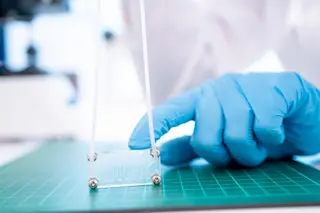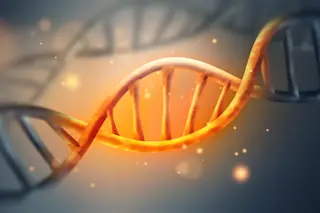UPDATE: On Tuesday, Gilles-Eric Séralini responded by email to the criticisms in this post. Mostly, he says, the answers can be found in the study itself. But where he has addressed these criticisms in particular, we have included that below in italics. Séralini stresses that while the data he had available was limited, his findings show that you can't say these GM corn varieties are safe enough to put on the market and authorize for human consumption right now. On Wednesday, we covered the overreaction by a fewimportantonlinesources to an International Journal of Biological Sciences article claiming to find "signs of toxicity" in three varieties of genetically modified (GM) corn produced by Monsanto. We posted some caveats that made us uneasy about the study, such as the funding sources, the unknown quality of the journal, and the fact that the toxicity claims rely on reinterpreting statistical data that Gilles-Eric Séralini and his coauthors themselves note is not as robust as it needs to be. Karl Haro von Mogel, a University of Wisconsin Ph.D. student who works with Pamela Ronald (the GM expert we quoted in our last post), responded with some other problems he has on this study. He has a blog post of his own (in which he gets hopping mad at coverage that attributed organ damage, organ failure, or even cancer to the rats in the study). But here are the major issues he points out to DISCOVER: 1. Cherry-picking. "They were picking out about 20–30 significant measurements out of about 500 for one of the sets of data they analyzed," Haro von Mogel tells DISCOVER. "At the 95% significance level, you would expect that 5% of the observations would show a significant difference due to chance alone, which is what happened." In other words, one would expect to get some alarming results in approximately 25 out of the 500 of the measurements, which is indeed what they found. "Picking apart what seems to be normal background variability seems to me to be data dredging." Séralini: We have not chosen the significant measurements, we have listed all the parameters disturbed, all indicated by stars (see Tables joines), there are 20 on 60 for NK603, 15/60 for MON 810 and 23/60 for MON 863 (other paper published in 2007). This is a lot, concentrating mostly on liver and kidneys, the major organ reacting in case of chemical intoxication by food.One must understand that there are the only blood mammalian analyses allowing the commercialization of these GMOs in the world, these tests lasting only three months and kept secret for the crude data before our study. 2. "False Discovery Rate." The battle over these corn varieties has been cooking for years; Séralini and others published a paper in 2007 on the same issues, and after statistical criticisms like the ones just mentioned the authors came around with this new edition. One of the main shots scientists took at the previous paper, Haro von Mogel says, was that the team didn't employ a "false discovery rate"—a stringent statistical method that controls for false positives. This time they did, but for at least two of the three varieties—MON 810 and MON 863—the researchers themselves note p-values that are not significant. (A p-value is a measure of the likelihood that any particular finding was due to chance alone rather than a real effect. By convention, science calls anything that has a greater than 5 percent chance of being a random effect "insignificant.")
Séralini: Our conclusions are that it is necessary to request from the industry to prolongate the tests before commercialization (2 years for chronic tests, like usually for drugs or pesticides tested on rats). Signs of chronic pathologies (cancers, hormonal diseases, metabolic diseases...) could be the same when measured within three months only. Don't forget that there are positive FDR results, preoccupying (see our discussion in the paper). If the spleen is increased by 18% significantly, or the heart by 11% when eating GMO foods within 3 months, how could it be scientifically and socially acceptable to authorize these GM for all people to eat that during their entire life ?
3. "Insignificant" results. As you can see in the study's chart, there a significant effect shown in "Lar uni cell" (large unnucleated cell count) for female rats fed the GM corn as 11 percent of their diet. But for female rats fed three times as much GM corn, it's not there. "Are they highlighting random variation or finding genuine effects? These are the kinds of questions that scientists need to address before concluding that they have found 'signs of toxicity,'"Haro von Mogel asks. (Séralini et al. have argued that more attention needs to be paid to nonlinear toxic effects, where greater doses would cause less harm.)
Séralini: The hypothesis that a side effect should be linear or proportional to the dose (when Monsanto used only two doses) to be taken into account is not scientific.
A difference in crude weight accompanied by a difference in relative weight (vs body weight) should be noted, it constitutes another information, in Monsanto's file also. Both results are similarly significant. For instance if you increase weight, your liver increase, but in can increase more than the body, it is preoccupying still. 4. Lack of corroboration or explanation. The government organization Food Standards for Australia and New Zealand (which disputed Séralini's 2007 paper [Microsoft Word file]), also disputes the recent study, in part because there is no other science corroborating the statistical data—data that was challenged in the previous points. Their response concludes by saying, "The authors do not offer any plausible scientific explanations for their hypothesis, nor do they consider the lack of concordance of the statistics with other investigative processes used in the studies such as pathology, histopathology and histochemistry...Reliance solely on statistics to determine treatment related effects in such studies is not indicative of a robust toxicological analysis. There is no corroborating evidence that would lead independently to the conclusion that there were effects of toxicological significance. FSANZ remains confident that the changes reported in these studies are neither sex- nor dose-related and are primarily due to chance alone." We emailed Séralini to ask if he would respond to these particular criticisms, and have not yet heard a response. But the study is currently available to read for free, and you can see a YouTube clip of him discussing this paper, his methods, and his criticisms of Monsanto. In light of these concerns regarding the study, it would be an enormous stretch to say the study proves that these corn varieties cause organ damage in mammals. But none of this puts Monsanto's GM corn totally in the clear, either. As commenters on our earlier post pointed out, Monsanto was simply following the rather laissez-faire rules for government approval, doing the 90-day trials themselves. But Séralini's team calls for long-term studies, upwards of two years, to get reliable data. With the dearth of available data, which Monsanto was loath to give up to the researchers in the first place, strong conclusions are tough to come by. As Per Pinstrup-Andersen, a Cornell food expert not associated with Haro von Mogel's team, sums up this study: "It is very convoluted but the authors imply that the results are not scientifically valid by recommending a study "to provide true scientifically valid data,'" he tells DISCOVER. But, as Séralini notes in his YouTube clip, that scientifically valid study would cost a fortune. And considering that these biotech crops have already been approved, Monsanto has little incentive to continue testing them. Related Content: 80beats: GM Corn Leads to Organ Failure!? Not So Fast 80beats: New Biotech Corn Gives Triple Vitamin Boost; Professors Unmoved 80beats: Germany Joins the European Mutiny of Genetically Modified Crops DISCOVER: Genetically Altered Corn tells how a corn not intended for humans got into the food supply
Image: flickr / Peter Blanchard














